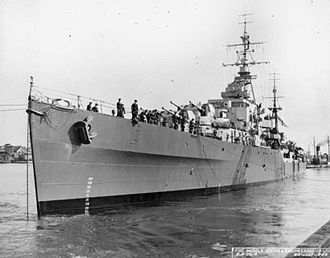This article includes a list of general references, but it lacks sufficient corresponding inline citations .(June 2008) |
 Black Prince at anchor on the River Tyne, July 1944 | |
| History | |
|---|---|
| Name | Black Prince |
| Namesake | Edward, the Black Prince |
| Builder | Harland & Wolff, Belfast, Northern Ireland |
| Yard number | 1049 [1] |
| Laid down | 2 November 1939 |
| Launched | 27 August 1942 |
| Completed | 20 November 1943 [1] |
| Commissioned | 30 November 1943 |
| Decommissioned | March 1962 |
| Out of service | Loaned to the Royal New Zealand Navy, 25 May 1946 |
| Fate | Scrapped, 2 May 1962 |
| Notes | Pennant number: 81 |
| Name | HMNZS Black Prince |
| Commissioned | 25 May 1946 |
| Out of service | Returned to Royal Navy control, 1 April 1961 |
| General characteristics (as built) | |
| Class & type | Dido-class light cruiser |
| Displacement |
|
| Length | |
| Beam | 50.5 ft (15.4 m) |
| Draught | 14 ft (4.3 m) |
| Installed power |
|
| Propulsion | 4 shafts; 4 geared steam turbines |
| Speed | 32.25 knots (59.73 km/h; 37.11 mph) |
| Range | 6,824 km (3,685 nmi; 4,240 mi) at 16 knots (30 km/h; 18 mph) |
| Complement | 530 |
| Armament | |
| Armour | |
HMS Black Prince was a Dido-class light cruiser of the Royal Navy, of the Bellona subgroup. The cruiser was commissioned in 1943, and served during World War II on the Arctic convoys, during the Normandy landings, and as part of the British Pacific Fleet. In 1946, the cruiser was loaned to the Royal New Zealand Navy, becoming HMNZS Black Prince. The cruiser was docked for modernisation in 1947, but in April, her sailors walked off the ship as part of a series of mutinies in the RNZN. The shortage of manpower resulting from these mutinies meant that the modernisation had to be cancelled, and Black Prince was placed in reserve until 1953. She returned to service after refitting with simplified secondary armament with a single quad "pom pom" in Q position and eight Mk3 40mm Bofors guns. The ship was decommissioned again two years later, and returned to the Royal Navy in 1961. Black Prince did not re-enter service, and was towed from Auckland to Osaka for scrapping in 1962.